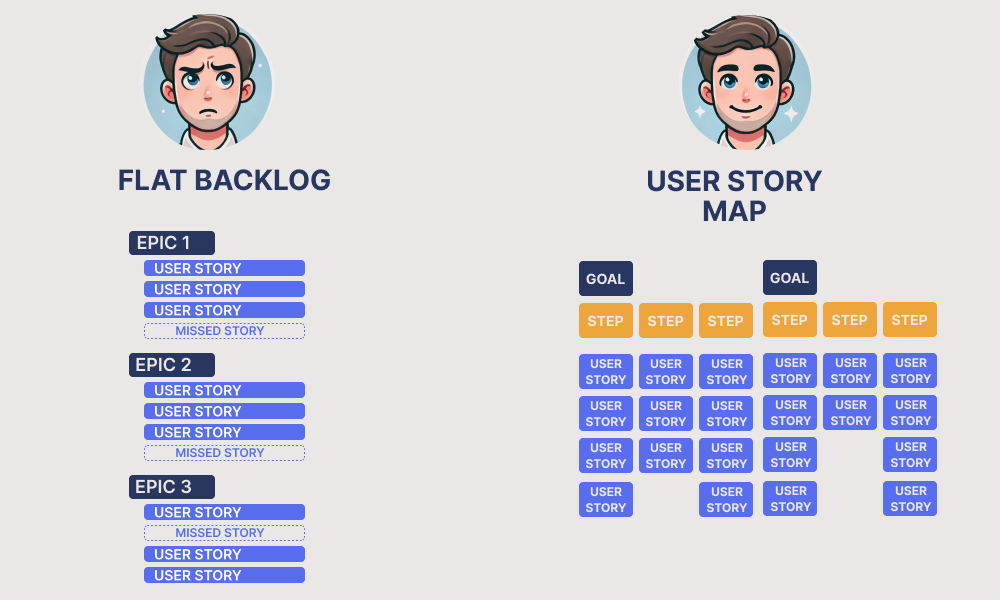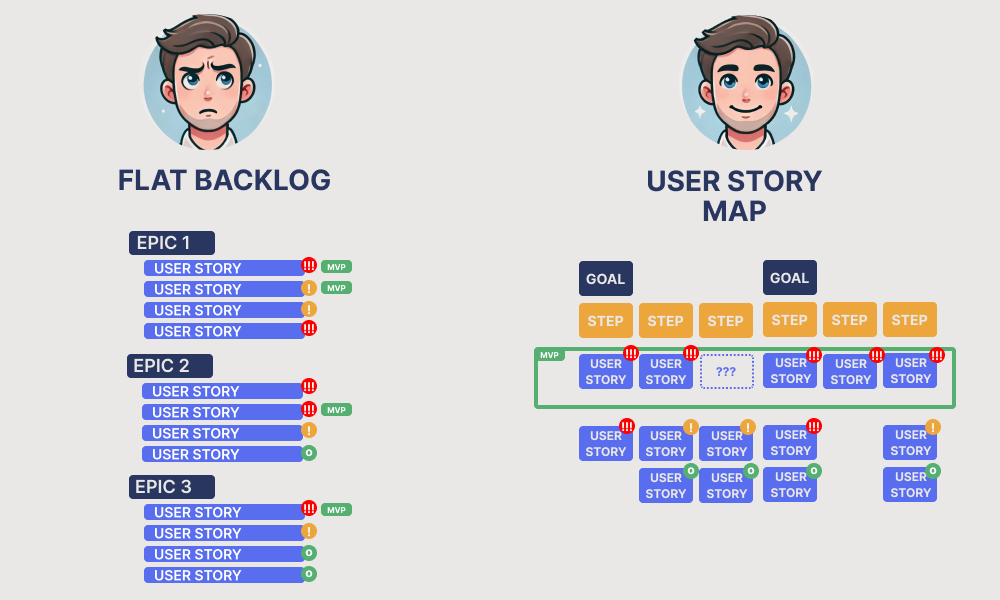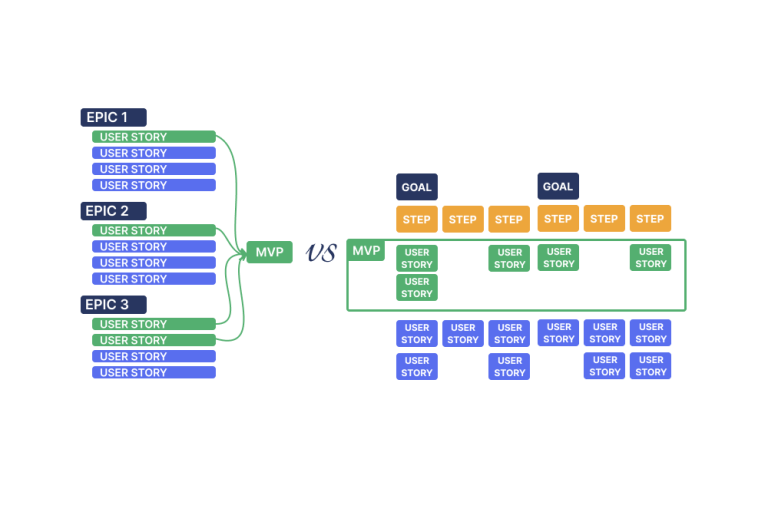In the world of product development, the acronym MVP carries dual significance. On one hand, it stands for Most Valuable Player, the standout team member who drives success. On the other hand, MVP refers to the Minimum Viable Product, the simplest version of a product that can be launched to validate an idea with minimal resources. Understanding both meanings is crucial, but defining your MVP effectively sets the foundation for a successful product launch.
This article delves into how User Story Mapping elevates MVP planning beyond traditional methods. By providing a clear, organized framework, User Story Mapping makes the process of identifying and prioritizing essential features not only easier but also laser-sharp. Discover why User Story Mapping is the ultimate tool for crafting an MVP that meets user needs and drives your product’s success.
MVP: A Quick Summary
MVP, or Minimum Viable Product, is the simplest version of a product that can be launched to validate an idea with minimal resources. It focuses on core features that address the primary needs of users, enabling teams to gather feedback and make informed decisions for future development.
For a more detailed exploration, check out our previous article on MVP in Programming.
What is MVP?
An MVP serves as the foundational step in product development, encompassing essential features that solve specific user problems. It allows teams to test assumptions, gather user feedback, and iterate quickly without significant investment. By prioritizing what truly matters, an MVP ensures that the final product aligns with user needs and market demands.
How to Create the MVP with user story mapping
Creating an MVP with User Story Mapping involves a systematic approach that prioritizes the most critical features to validate your product idea. This method ensures that every element of the MVP directly contributes to delivering value to users, making the planning process efficient and highly focused. By utilizing User Story Mapping, teams can visualize the user journey, prioritize essential functionalities, and select the right features to include in the MVP. This results in a streamlined, laser-sharp product development process that outperforms traditional planning methods.
1. Map the user journey
What It Involves
Mapping the user journey involves outlining the user’s complete experience with your product, from initial interaction to achieving their goals. This step visualizes the various stages and touchpoints, providing a comprehensive view of how users navigate and interact with the product.

Flat Backlog vs User Story Mapping
While maintaining a flat backlog is a common approach for organizing product features and tasks, it often falls short in critical areas compared to User Story Mapping:
- Risk of Missing Critical Features: A flat backlog’s linear and unstructured nature increases the likelihood of overlooking essential user steps. This can lead to missing important user stories or vital features for a seamless and complete MVP.
- Not User-Centric: A flat backlog lists features and tasks without considering the user’s journey. This lack of focus on the user experience can lead to developing functionalities that may not align with actual user needs and behaviors.
- Limited Overview of User Steps: A flat backlog makes it difficult to see how users interact with the product step-by-step without a visual representation of the user journey. This obscures the overall flow and can result in disjointed or fragmented user experiences.
Benefit Compared to Other Methods: Understanding the User Persona
- User Story Mapping: By mapping the user journey, teams gain deep insights into user personas, understanding their needs, motivations, and pain points. This empathetic approach ensures that the product is tailored to actual user experiences.
- Other Methods: Techniques like the Business Model Canvas or Lean Startup often focus more on business aspects or hypothesis testing, potentially overlooking individual user personas’ nuanced behaviors and needs.
2. Brainstorm User Stories
What It Involves:
Brainstorming user stories entails generating detailed descriptions of features from the user’s perspective. These stories capture what users want to achieve and their expected value, serving as the foundation for feature development.

Flat Backlog vs User Story Mapping
While maintaining a flat backlog is a common approach for organizing product features and tasks, it often falls short in critical areas compared to User Story Mapping:
- Not User-Centric: A flat backlog typically organizes tasks and features without considering the user’s journey. This feature-centric approach can lead team members to focus solely on individual functionalities rather than how each feature serves users’ needs. In contrast, User Story Mapping ensures that every feature aligns with specific user journey steps, fostering a more user-focused development process.
- Limited Overview of User Steps: A flat backlog without a visual representation makes it difficult to understand the sequence and flow of user interactions with the product. This lack of clarity can obscure how different features interconnect and support the overall user experience. User Story Mapping provides a clear and comprehensive visual overview of all user steps, enabling team members to grasp the entire user journey effortlessly.
- Risk of Missing Critical Features: A flat backlog’s linear and unstructured nature increases the likelihood of overlooking essential user steps, leading to missed user stories or vital features. This oversight can result in an incomplete MVP that doesn’t fully address user needs. User Story Mapping mitigates this risk by ensuring all necessary steps are accounted for, making brainstorming sessions more fruitful and ensuring a complete and cohesive MVP.
Benefit Compared to Other Methods: Visual Overview of Possible Solutions
- User Story Mapping: Provides a visual and collaborative platform where teams can collectively brainstorm and organize user stories. This visual overview facilitates the identification of comprehensive solutions and ensures that all potential user needs are considered.
- Other Methods: Approaches like Value Proposition Canvas focus primarily on aligning product value with customer needs but may lack a structured, visual representation of individual user stories and their interconnections.
3. Prioritize User Stories
What It Involves
Prioritizing user stories means evaluating and ranking them based on user value, feasibility, and business impact. This step ensures that the most critical features are addressed first, aligning development efforts with strategic goals.

Flat Backlog vs User Story Mapping
While maintaining a flat backlog is a common approach for organizing product features and tasks, it often falls short in critical areas compared to User Story Mapping:
- Collaboration with Non-Technical Stakeholders: User Story Mapping allows prioritization with non-technical stakeholders thanks to its clear and intuitive layout. Flat backlogs are feature-centric, making it difficult for non-technical members to understand and contribute to priority decisions.
- Visual Prioritization with Swimlanes: User Story Mapping uses swimlanes to effectively highlight and organize priorities. Flat backlogs lack visual tools, making it challenging to emphasize which features are most important.
- Easy Overview of Priorities: User Story Mapping provides an easy-to-understand prioritization layout, enabling quick and informed decision-making. Flat backlogs do not offer a clear overview, making it hard to discern what’s important at a glance.
- Clear Priority Among Epics:
User Story Mapping clearly defines priorities among larger work items or epics, ensuring strategic alignment. Flat backlogs have unclear epic prioritization, which can lead to misaligned efforts and overlooked critical features.
Benefit Compared to Other Methods: Easy-to-Understand Priorities
- User Story Mapping offers a straightforward and transparent prioritization process. User stories are arranged in a sequence that reflects their importance and relevance to the user journey. This clarity helps teams make informed decisions quickly.
- Other Methods: Techniques like Impact Mapping focus on strategic alignment but may involve more complex frameworks that can be harder to interpret and apply directly to feature prioritization.
4. Slice Out the MVP
What It Involves
Slicing out the MVP involves selecting a subset of user stories that form a complete and functional user journey. This ensures that the MVP delivers value by addressing essential user needs without unnecessary features.

Flat Backlog vs User Story Mapping
User Story Mapping uses swimlanes to offer a highly visual approach to creating MVP releases. This visual layout makes it easy for team members to understand and navigate the MVP structure, ensuring that all essential features are included. Additionally, User Story Mapping allows teams to verify that the user journey is complete, preventing gaps in functionality and enhancing user satisfaction.
- Visual MVP Releases with Swimlanes: User Story Mapping uses Swimlanes to create an extremely visual MVP release plan, allowing team members to easily see and understand the structure and priorities. Flat Backlog lacks this visual organization, making it challenging to create a clear and comprehensive MVP release plan.
- Ensuring Complete User Journey: User Story Mapping enables teams to check whether the user journey is complete, ensuring that all necessary user stories and features are included in the MVP. Flat Backlog does not provide a straightforward way to verify the completeness of the user journey, increasing the risk of missing critical features.
Benefit Compared to Other Methods: Selecting User Stories to Keep the User Journey Complete
- User Story Mapping: Ensures the MVP retains a coherent and complete user journey by carefully selecting user stories that collectively provide a seamless experience. This holistic approach prevents gaps in functionality and maintains user satisfaction.
- Other Methods: Methods like Agile (Scrum/Kanban) focus on iterative development and continuous delivery but may not inherently ensure that the selected features collectively complete a user journey, potentially leading to fragmented MVPs.
Why User Story Mapping Excels Over Other Methods
While alternative MVP planning methods each offer unique strengths, User Story Mapping uniquely combines user-centric design with structured prioritization and comprehensive planning. By meticulously mapping the user journey, brainstorming and prioritizing user stories visually, and carefully slicing out a complete MVP,
User Story Mapping ensures that every aspect of the product aligns with user needs and business objectives. This integrated approach mitigates the limitations found in other methods, such as fragmented feature sets, lack of user persona insights, and complex prioritization frameworks, making User Story Mapping the superior choice for defining a laser-sharp MVP.
Outcome-Driven MVPs: Map Metrics and Experiments
MVPs win when they’re built to learn. Extend your story map with outcomes, metrics, and testable hypotheses so every slice is designed not just to ship features but to validate assumptions and cut risk.
- Attach clear outcomes to activities or epics (e.g., activation rate, time-to-value, task success) and align them with team OKRs.
- Add hypothesis notes to key stories: we believe change X for user Y will produce result Z; we’ll know it worked when metric M moves by N%.
- Instrument each step with analytics events and a lightweight tracking plan; use feature flags for controlled rollouts and A/B tests.
- Include learning stories in every slice (usability tests, concierge trials, interviews) and capture insights on the map.
- Schedule decision checkpoints after each slice to pivot, persevere, or expand based on data, then update priorities on the map.
Treat metrics and experiments as first-class citizens on the map to turn releases into measurable bets, speed up decisions, and keep your MVP moving toward outcomes that matter.
Other Methods to Plan an MVP
When defining and planning a Minimum Viable Product (MVP), several methodologies can help teams outline their product’s essential features and validate their ideas. Here are some of the most popular alternatives to User Story Mapping:
1. Lean Startup Methodology
Overview: Developed by Eric Ries, the Lean Startup approach emphasizes building a product iteratively using the Build-Measure-Learn feedback loop. It focuses on creating an MVP to test hypotheses about the product and its market.
Pros:
- Encourages rapid experimentation and learning.
- Minimizes waste by focusing only on essential features.
Cons:
- Can lead to a lack of comprehensive planning.
- May result in frequent pivots, which can be destabilizing for teams.
2. Business Model Canvas
Overview: Created by Alexander Osterwalder, the Business Model Canvas is a strategic management tool that outlines key components of a business model, including value propositions, customer segments, and revenue streams. Learn more…
Pros:
- Provides a holistic view of the business.
- Facilitates clear communication among stakeholders.
Cons:
- Less focus on product-specific features.
- Can be too high-level for detailed MVP planning.
3. Value Proposition Canvas
Overview: This tool helps teams ensure their product meets customers’ needs and desires by mapping out the value proposition against customer segments.
Pros:
- Strong focus on customer needs.
- Enhances alignment between product features and user value.
Cons:
- May overlook technical constraints and feasibility.
- Primarily focused on value rather than feature prioritization.
4. Design Thinking
Overview: A user-centered approach that involves empathizing with users, defining problems, ideating solutions, prototyping, and testing.
Pros:
- Highly focused on user experience and needs.
- Encourages creativity and innovative solutions.
Cons:
- Can be time-consuming.
- May require specialized training for effective implementation.
5. Impact Mapping
Overview: A strategic planning technique that visualizes the relationships between goals, actors, impacts, and deliverables to ensure alignment with business objectives. Learn more…
Pros:
- Enhances strategic alignment and goal clarity.
- Helps in prioritizing features based on impact.
Cons:
- Can be complex to set up.
- May not provide detailed guidance on feature implementation.
6. Agile Methodologies (Scrum, Kanban)
Overview: Agile frameworks like Scrum and Kanban focus on iterative development, continuous feedback, and flexibility in responding to change.
Pros:
- Promotes adaptability and quick response to feedback.
- Encourages collaborative teamwork.
Cons:
- Can lack a structured approach to defining MVP scope.
- Requires disciplined execution to avoid scope creep.
Conclusion
In defining a successful Minimum Viable Product (MVP), choosing the right planning method is crucial. User Story Mapping stands out as the superior approach by offering a clear, user-focused framework that ensures every feature included in the MVP directly addresses user needs and business goals. Unlike other methods that may overlook detailed user journeys or struggle with prioritization, User Story Mapping provides a structured process to map the user journey, brainstorm and prioritize user stories, and carefully slice out a cohesive MVP.
By understanding the user persona, visualizing potential solutions, establishing clear priorities, and maintaining a complete user journey, teams can create an MVP that validates their product idea efficiently and lays a strong foundation for future development. This laser-sharp focus minimizes wasted resources and maximizes the value delivered to users from the outset.
Embracing User Story Mapping for MVP planning streamlines the development process and fosters better collaboration and alignment within teams. As demonstrated, this method effectively addresses the common pitfalls of other planning techniques, making it the most valuable tool in your product development arsenal. Start leveraging User Story Mapping today to build MVPs that resonate with your users and drive your product’s success.
User Story Mapping for MVP Planning: FAQ
What is user story mapping and why use it for MVPs?
User story mapping lays out the end-to-end journey and the stories that make it work. It helps teams rank what matters, then cut a complete, testable MVP—not a grab bag of features.
How is a story map better than a flat backlog?
A flat backlog hides the flow and makes it easy to miss critical steps. A story map centers on the user, visualizes the journey, and clarifies priorities with layers and swimlanes.
How do I run a story mapping workshop?
Start with a sharp persona and goal. Map the high-level activities, then break them into steps and stories. Co-create with stakeholders, group related items, and agree on priorities and the MVP slice.
How do we choose which stories go into the MVP?
Pick the smallest set of stories that deliver a complete end-to-end journey for your primary persona. Rank by user value, feasibility, and business impact, and drop nice-to-haves that don’t change the core outcome.
How does story mapping integrate with Scrum or Kanban?
Use the map to drive refinement and sprint—or flow—planning. Turn MVP slices into release plans, and keep the map living so you can realign priorities as you learn.
What metrics should we track after releasing the MVP?
Track activation, task success, time-to-value, and retention across the mapped journey. Combine metrics with interviews and observations, then update the map and backlog based on what you learn.
How detailed should personas be for mapping?
Keep personas lightweight but actionable—key goals, motivations, and pain points that shape the journey. Add detail as you validate with user feedback to avoid over-engineering early.
How do we ensure the MVP covers a complete journey?
Make sure every activity and step has at least one supporting story in the slice. Walk the map as the user and look for gaps, edge cases, and dependencies that could break the flow.
What common pitfalls should we avoid?
Common traps: shipping feature lists instead of journeys, skipping stakeholder alignment, and stuffing the MVP. Another: ignoring the map after feedback, which quickly skews priorities.
Can story mapping handle complex B2B products?
Yes. Use multiple personas, split long journeys into epics, and layer releases to manage complexity while keeping cross-functional teams aligned.
